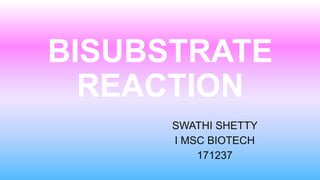Bisubstrate
•Download as PPTX, PDF•
12 likes•12,146 views
bisubstrate reactions
Report
Share
Report
Share

Recommended
Recommended
More Related Content
What's hot
What's hot (20)
Regulatory and allosteric enzymes and allostrerism

Regulatory and allosteric enzymes and allostrerism
PYRUVATE DEHYDROGENASE COMPLEX (PDH-MULTI-ENZYME COMPLEX)

PYRUVATE DEHYDROGENASE COMPLEX (PDH-MULTI-ENZYME COMPLEX)
Similar to Bisubstrate
Similar to Bisubstrate (20)
Recently uploaded
Antibiotics are medicines that fight infections caused by bacteria in humans and animals by either killing the bacteria or making it difficult for the bacteria to grow and multiply. Bacteria are germsABHISHEK ANTIBIOTICS PPT MICROBIOLOGY // USES OF ANTIOBIOTICS TYPES OF ANTIB...

ABHISHEK ANTIBIOTICS PPT MICROBIOLOGY // USES OF ANTIOBIOTICS TYPES OF ANTIB...ABHISHEK SONI NIMT INSTITUTE OF MEDICAL AND PARAMEDCIAL SCIENCES , GOVT PG COLLEGE NOIDA
Bioenergetics is an important domain in biology. This presentation has explored ATP production and its optimum utilization in biological systems along with certain theories and experiments to give a bird's eye view of this important issue.Energy is the beat of life irrespective of the domains. ATP- the energy curre...

Energy is the beat of life irrespective of the domains. ATP- the energy curre...Nistarini College, Purulia (W.B) India
Recently uploaded (20)
X-rays from a Central “Exhaust Vent” of the Galactic Center Chimney

X-rays from a Central “Exhaust Vent” of the Galactic Center Chimney
Human & Veterinary Respiratory Physilogy_DR.E.Muralinath_Associate Professor....

Human & Veterinary Respiratory Physilogy_DR.E.Muralinath_Associate Professor....
FAIRSpectra - Enabling the FAIRification of Spectroscopy and Spectrometry

FAIRSpectra - Enabling the FAIRification of Spectroscopy and Spectrometry
TransientOffsetin14CAftertheCarringtonEventRecordedbyPolarTreeRings

TransientOffsetin14CAftertheCarringtonEventRecordedbyPolarTreeRings
POGONATUM : morphology, anatomy, reproduction etc.

POGONATUM : morphology, anatomy, reproduction etc.
Understanding Partial Differential Equations: Types and Solution Methods

Understanding Partial Differential Equations: Types and Solution Methods
Module for Grade 9 for Asynchronous/Distance learning

Module for Grade 9 for Asynchronous/Distance learning
ABHISHEK ANTIBIOTICS PPT MICROBIOLOGY // USES OF ANTIOBIOTICS TYPES OF ANTIB...

ABHISHEK ANTIBIOTICS PPT MICROBIOLOGY // USES OF ANTIOBIOTICS TYPES OF ANTIB...
FAIRSpectra - Enabling the FAIRification of Analytical Science

FAIRSpectra - Enabling the FAIRification of Analytical Science
GBSN - Biochemistry (Unit 2) Basic concept of organic chemistry 

GBSN - Biochemistry (Unit 2) Basic concept of organic chemistry
Efficient spin-up of Earth System Models usingsequence acceleration

Efficient spin-up of Earth System Models usingsequence acceleration
Porella : features, morphology, anatomy, reproduction etc.

Porella : features, morphology, anatomy, reproduction etc.
Energy is the beat of life irrespective of the domains. ATP- the energy curre...

Energy is the beat of life irrespective of the domains. ATP- the energy curre...
Bisubstrate
- 1. BISUBSTRATE REACTION SWATHI SHETTY I MSC BIOTECH 171237
- 2. BISUBSTRATE REACTION • When an enzyme catalyzing a reaction involving two substrates and yields two products it is called as bisubstrate reaction. • Approximately 60% reaction accounts for biochemical reaction. A + B P + Q
- 3. • It is either transferase reaction in which the enzyme catalyzes the transfer of a specific functional group, from one of the substrate to the other. P-X + B P + B-X • Bisubstrate reaction is a oxidation reduction reaction in which reducing equivalents are transferred between the two substrates.
- 4. Example: Hydrolysis of peptide bond by trypsin is the transfer of the peptide carbonyl group from the peptide nitrogen atom to water.
- 5. • W. Cleland introduced a nomenclature system for representing enzymatic reaction: • Substrate is represented by A, B, C and D. • Products is represented by P. Q, R and S. • Stable enzymes forms are designated by E, F and G. • The number of reactants and products in a given reaction are specified in order, by Uni (one), Bi (two), Ter (three) and Quad (four). The reaction that requires two substrate and yield two products that is Bi Bi reactions.
- 6. TYPES OF BI BI REACTION • They are of two major types namely: 1. SEQUENTIAL REACTIONS: oAll the substrates involved are bound to the enzyme before catalysis of the reaction takes place to release the products. oIt is also called Single Displacement reactions. oBoth substrate and enzymes forms ternary complex. oIt is sub-classified into two types: ordered sequential reaction and random sequential reaction
- 7. ORDERED SEQUENTIAL REACTION • All the substrates are bound to the enzyme in a defined order or sequence. The products too, are released after catalysis in a defined order or sequence.
- 8. • Example : lactate dehydrogenase enzyme catalyzes glucose metabolism.
- 9. RANDOM SEQUENTIAL REACTION • The substrate and products are bound and then released in no preferred order or ‘random’ order.
- 10. Example: Creatine kinase enzyme which catalyzes the substrate creatine and ATP ,to form the products, phosphocreatine and ADP.
- 11. 2. PING PONG REACTION: • Mechanism in which one or more products are released before all substrates have been added are known as Ping Pong reaction. • Also called as Double Displacement reaction. • It is characterized by the change of the enzyme into an intermediate form when the first substrate to product reaction occurs.
- 12. • This indicates temporary and the enzyme must be found in its original form at the end of the reaction.
- 13. Example: The enzyme aspartate amino transferase catalyzes the transfer of an amino group from aspartate to alpha ketoglutarate.
- 14. REFERENCE • Voet Donald and Voet Judith, ‘Biochemistry’, second edition;1995, Pg. 362-363. • Garett Regnard and Grisham Charles, ‘Biochemistry’, second edition; 1999, Pg. 448-454.